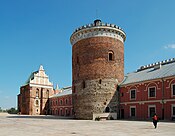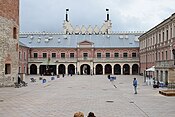Lublin Castle
| Lublin Royal Castle Zamek Lubelski (in Polish) | |
|---|---|
Polish Gothic-Gothic Revival | |
| Town or city | Lublin |
| Country | Poland |
| Coordinates | 51°15′02″N 22°34′20″E / 51.25056°N 22.57222°E |
| Construction started | 12th century |
| Demolished | 1655−1657, rebuilt 1826-1828 as prison |
| Client | Casimir II the Just |
Historic Monument of Poland | |
| Designated | 2007-04-25 |
| Part of | Lublin – historic architectural and urban ensemble |
| Reference no. | Dz. U. z 2007 r. Nr 86, poz. 574[1] |
The Lublin Castle (Polish: Zamek Lubelski) is a medieval castle in Lublin, Poland, adjacent to the Old Town district and close to the city center. It is one of the oldest preserved royal residencies in Poland, initially established by High Duke Casimir II the Just.[2] Its contemporary Gothic Revival appearance is largely due to a reconstruction undertaken in the 19th century.
History
The hill it is on was first fortified with a wood-reinforced earthen wall in the 12th century. In the first half of the 13th century, the stone keep was built. It still survives[2] and is the tallest building of the castle, as well as the oldest standing building in the city. In the 14th century, during the reign of Casimir III the Great, the castle was rebuilt with stone walls. Probably at the same time, the castle's Chapel of the Holy Trinity was built as a royal chapel.[2]
In the first decades of the 15th century, King

Under the rule of the
As a consequence of the wars in the 17th century (
The castle was a prison for the next 128 years: as a Tsarist prison from 1831 to 1915, in independent Poland from 1918 to 1939, and most infamously during the
In 1954, the castle prison was closed. Following reconstruction and refurbishment, since 1957 it has been the main site of the National Museum.
Gallery
-
View of the castle in 1826
-
Main entrance gate of the neo-gothic part of the building
-
The keep and the Holy Trinity Chapel seen from the castle's courtyard
-
Courtyard of the castle
See also
- Castles in Poland
References
- ^ Rozporządzenie Prezydenta Rzeczypospolitej Polskiej z dnia 25 kwietnia 2007 r. w sprawie uznania za pomnik historii "Lublin - historyczny zespół architektoniczno-urbanistyczny", Dz. U. z 2007 r. Nr 86, poz. 574
- ^ a b c d e f g h i (in English) "A Brief History of Lublin Castle". eng.zamek.lublin.pl. Archived from the original on 2011-08-15. Retrieved 2010-09-15.
- ^ ISBN 3-88618-088-3.
- ^ a b Śladami Unii Lubelskiej. Spacer po Lublinie (in Polish). Lublin. 2010. p. 30.
{{cite book}}: CS1 maint: location missing publisher (link) - ISBN 0-7864-1625-4.
- ^ a b c Śladami Unii Lubelskiej. Spacer po Lublinie, p. 32
External links





